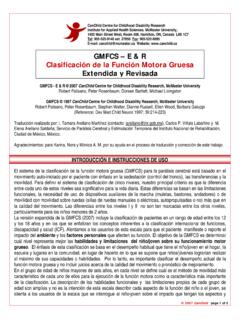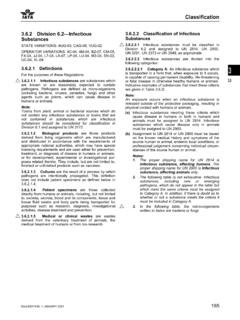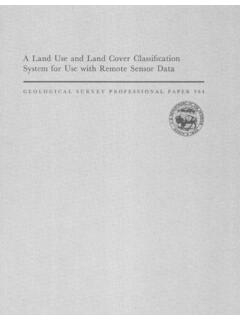Transcription of GMFCS - E & R English
1 CanChild Centre for Childhood Disability Research Institute for Applied Health Sciences, McMaster University, 1400 Main Street West, Room 408, Hamilton, ON, Canada L8S 1C7. Tel: 905-525-9140 ext. 27850 Fax: 905-522-6095. E-mail: Website: GMFCS E & R. Gross Motor Function classification System Expanded and Revised GMFCS - E & R Robert Palisano, Peter Rosenbaum, Doreen Bartlett, Michael Livingston, 2007. CanChild Centre for Childhood Disability Research, McMaster University GMFCS Robert Palisano, Peter Rosenbaum, Stephen Walter, Dianne Russell, Ellen Wood, Barbara Galuppi, 1997. CanChild Centre for Childhood Disability Research, McMaster University (Reference: Dev Med Child Neurol 1997;39:214-223).
2 INTRODUCTION & USER INSTRUCTIONS. The Gross Motor Function classification System ( GMFCS ) for cerebral palsy is based on self-initiated movement, with emphasis on sitting, transfers, and mobility. When defining a five-level classification system, our primary criterion has been that the distinctions between levels must be meaningful in daily life. Distinctions are based on functional limitations, the need for hand-held mobility devices (such as walkers, crutches, or canes) or wheeled mobility, and to a much lesser extent, quality of movement. The distinctions between Levels I and II are not as pronounced as the distinctions between the other levels, particularly for infants less than 2 years of age.
3 The expanded GMFCS (2007) includes an age band for youth 12 to 18 years of age and emphasizes the concepts inherent in the World Health Organization's International classification of Functioning, Disability and Health (ICF). We encourage users to be aware of the impact that environmental and personal factors may have on what children and youth are observed or reported to do. The focus of the GMFCS is on determining which level best represents the child's or youth's present abilities and limitations in gross motor function. Emphasis is on usual performance in home, school, and community settings ( , what they do), rather than what they are known to be able to do at their best (capability).
4 It is therefore important to classify current performance in gross motor function and not to include judgments about the quality of movement or prognosis for improvement. The title for each level is the method of mobility that is most characteristic of performance after 6 years of age. The descriptions of functional abilities and limitations for each age band are broad and are not intended to describe all aspects of the function of individual children/youth. For example, an infant with hemiplegia who is unable to crawl on his or her hands and knees, but otherwise fits the description of Level I ( , can pull to stand and walk), would be classified in Level I.
5 The scale is ordinal, with no intent that the distances between levels be considered equal or that children and youth with cerebral palsy are equally distributed across the five levels. A summary of the distinctions between each pair of levels is provided to assist in determining the level that most closely resembles a child's/youth's current gross motor function. We recognize that the manifestations of gross motor function are dependent on age, especially during infancy and early childhood. For each level, separate descriptions are provided in several age bands. Children below age 2 should be considered at their corrected age if they were premature.
6 The descriptions for the 6 to 12 year and 12 to18 year age bands reflect the potential impact of environment factors ( , distances in school and community) and personal factors ( , energy demands and social preferences) on methods of mobility. An effort has been made to emphasize abilities rather than limitations. Thus, as a general principle, the gross motor function of children and youth who are able to perform the functions described in any particular level will probably be classified at or above that level of function; in contrast, the gross motor function of children and youth who cannot perform the functions of a particular level should be classified below that level of function.
7 OPERATIONAL DEFINITIONS. Body support walker A mobility device that supports the pelvis and trunk. The child/youth is physically positioned in the walker by another person. Hand-held mobility device Canes, crutches, and anterior and posterior walkers that do not support the trunk during walking. Physical assistance Another person manually assists the child/youth to move. Powered mobility The child/youth actively controls the joystick or electrical switch that enables independent mobility. The mobility base may be a wheelchair, scooter or other type of powered mobility device. Self-propels manual wheelchair The child/youth actively uses arms and hands or feet to propel the wheels and move.
8 Transported A person manually pushes a mobility device ( , wheelchair, stroller, or pram) to move the child/youth from one place to another. Walks Unless otherwise specified indicates no physical assistance from another person or any use of a hand-held mobility device. An orthosis ( , brace or splint) may be worn. Wheeled mobility Refers to any type of device with wheels that enables movement ( , stroller, manual wheelchair, or powered wheelchair). GENERAL HEADINGS FOR EACH LEVEL. LEVEL I - Walks without Limitations LEVEL II - Walks with Limitations LEVEL III - Walks Using a Hand-Held Mobility Device LEVEL IV - Self-Mobility with Limitations; May Use Powered Mobility LEVEL V - Transported in a Manual Wheelchair DISTINCTIONS BETWEEN LEVELS.
9 Distinctions Between Levels I and II - Compared with children and youth in Level I, children and youth in Level II. have limitations walking long distances and balancing; may need a hand-held mobility device when first learning to walk; may use wheeled mobility when traveling long distances outdoors and in the community; require the use of a railing to walk up and down stairs; and are not as capable of running and jumping. Distinctions Between Levels II and III - Children and youth in Level II are capable of walking without a hand-held mobility device after age 4 (although they may choose to use one at times). Children and youth in Level III need a hand-held mobility device to walk indoors and use wheeled mobility outdoors and in the community.
10 Distinctions Between Levels III and IV - Children and youth in Level III sit on their own or require at most limited external support to sit, are more independent in standing transfers, and walk with a hand-held mobility device. Children and youth in Level IV function in sitting (usually supported) but self-mobility is limited. Children and youth in Level IV are more likely to be transported in a manual wheelchair or use powered mobility. Distinctions Between Levels IV and V - Children and youth in Level V have severe limitations in head and trunk control and require extensive assisted technology and physical assistance.









